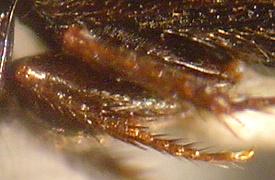
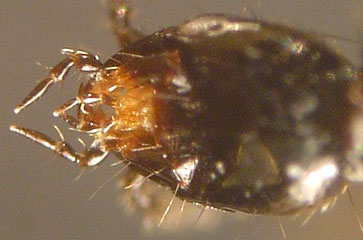
G. microphthalmus: Tarsus with unmodified setae
G. picipennis: Palps: last labial palp narrower than penultimate
Introduction
The genus Gabrius is a diverse genus of predaceous rove beetles within the Staphylininae with 42 species having been recorded in North America. Smetana (1995) is the definitive treatment of the group. Of the 42 Nearctic species only 5 have been recorded in Atlantic Canada. Much of the following account is abridged from Smetana (1995).
Within the subtribe Philolonthina Gabrius is differentiated as follows: First four segments of protarsus with ventral face bearing only regular, unmodified marginal setae, each simple and not dilated; lateral puncture of pronotum, bearing long seta, situated close to superior line of prontal hypomeron, either touching it or separated by distance of puncture; last segment of labial palpus slender, distinctly narrower than preceding segment.

|

|
|
G. microphthalmus: Tarsus with unmodified setae |
G. picipennis: Palps: last labial palp narrower than penultimate |
The following key to species in the Atlantic region is adapted from descriptions given in Smetana (1995) and relies solely on characters of external morphology.
Key to Maritime Provinces species of Gabrius
Descriptions and Bionomic Notes1. Greater than 6.0 mm. - Gabrius austutoides (Strand)
- Less than 6.0 mm - 22. Head, pronotum, and particularly elytra with greenish metallic lustre. Legs pale yellowish. Length 4.2-5.0 mm. - Gabrius ulpinus Smetana
- Not as above. Length variable. - 33. Dorsal rows of pronotum normally with 5 punctures. Scutellum with a few fine punctures. Length 4.8-6.0 mm. - Gabrius brevipennis (Horn)
- Dorsal rows of pronotum normally with 6 punctures. Scutellum punctate to densely punctate. Length 3.9-6.0 mm. 4.4. Elytra and abdominal segments piceous, piceous-black to black throughout,; elytra sometimes somewhat paler. Length 3.9-6.0 mm. - Gabrius picipennis (Mäklin)
- Elytra and apical margins of abdominal tergites more or less paler, rather piceous brown. Length 4.0-4.9 mm. - Gabrius microphthalmus (Horn)
Gabrius brevipennis (Horn) - 4.8-6.0 mm. Piceous black, pronotum and particularly elytra more or less paler, abdomen slightly iridescent; palps reddish-brown, antennae dark-brown to piceous, basal 3 segments paler; legs testaceous to reddish-brown, tarsi paler, medial faces of hind tibiae distinctly darkened. Head rounded quadrangular, slightly longer than wide (ratio 1:1.2). Dorsal rows of pronotum with 5 (occasionally 6 or 7) punctures. Scutellum with a few fine punctures.
This species has been found in a wide variety of habitats in fallen leaves or other debris in moist areas in coniferous and deciduous forests, along streams, springs, in wet meadows and marshes. They are also found in rotting wood, mosses, lichens, and rotting moldy bark. It is a transcontinental northern species found across Canada, north to Alaska and south to northern New England.
Gabrius picipennis (Mäklin) - 3.9-6.0 mm. Piceous, piceous-black to black, elytra sometimes somewhat paler; head, pronotum, and elytra sometimes with inconspicuous, dark, metallic lustre, abdomen slightly iridescent. Palps piceous to black, antennae piceous with basal 2-3 segments no more than inconspicuously paler, or entirely black; legs brown to piceous, tarsi paler. Medial faces of hind tibia darkened or almost entirely black. Head rounded quadrangular. Scutellum punctate.
This is a common species in a wide variety of habitats, however moist and wet habitats near running or standing water are preferred. Edges of ponds, lakes and creeks, wet meadows, forest seepages, swamps, bogs and marshes are all preferred habitats. They are found in fallen leaves, flood debris, in rotting plant debris and in material from beaver and muskrat houses. It is very broadly distributed throughout North America in all regions except for the American southeast and Great Plains.
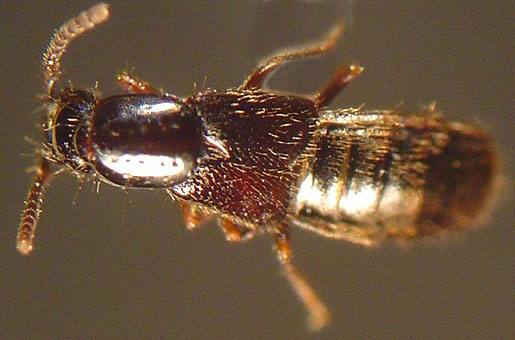
|
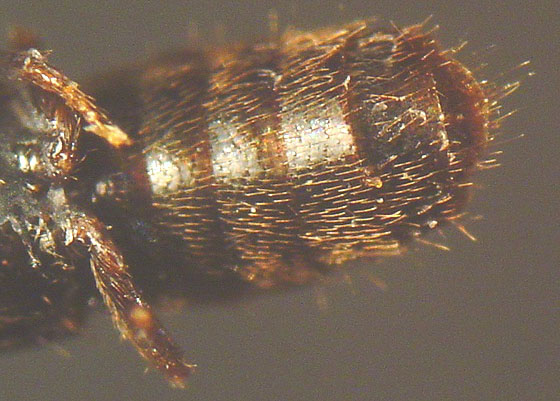
|
|
G. picipennis: Dorsal habitus |
Abdominal segments dark. |
Gabrius microphthalmus (Horn) - 4.0-4.9 mm. Piceous black to black with elytra and apical margins of abdominal tergites more or less paler, rather piceous brown. Head, pronotum, and abdomen slightly iridescent. Maxillary palps piceous with last segment paler; labial palps dark brown; antennae piceous-black, basal three segments inconspicuously paler. Legs testaceo-brunneous with medial faces of all tibiae (front tibiae sometimes excluded) darkened. Head rounded quadrangular. Scutellum densely punctate. Dorsal rows of pronotum with 6 (occasionally 5 or 7) punctures.
This is a common species in a wide variety of habitats. It seems to prefer decaying organic material, particularly rotting mushrooms. It has been found in compost piles, in deserted beaver lodges, in nests of Microtus pennsylvanicus under old hay bales and in rotting wood. It occurs in leaf litter, wet forest moss and has been found in a dead maple buttress. It is widely distributed in eastern North America.
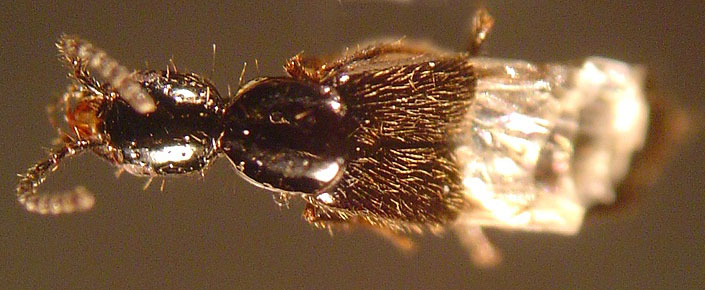
|
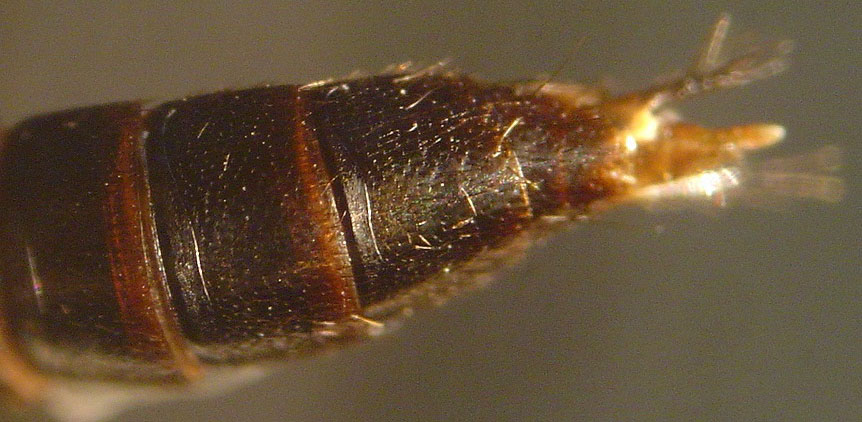
|
|
G. microphthalmus: Dorsal habitus |
Pale apical margins on abdominal segments. |
Gabrius ulpinus Smetana - 4.2-5.0 mm. Piceous black to black with elytra often inconspicuously paler; head, pronotum, and particularly elytra with greenish metallic lustre; abdomen iridescent, palps brunneous with last segment somewhat darker; antennae piceous, basal three segments more or less paler, two outer segments more or less paler, penultimate segment less than ultimate segment. Legs uniformly pale yellowish. Dorsal rows of pronotum with 6 (occasionally 5 or 7) punctures. Scutellum punctate.
It seems to prefer deciduous forested habitats where it is found in various forest floor debris, particularly in moist and deep leaf litter layers. It has been found in moss, under ferns, in old mushrooms and in rotten wood. Most records are from the Appalachian chain from North Carolina north to Quebec although it has also been found west to Ohio and east to Cape Breton Island.
Gabrius austutoides (Strand) - 6.0-6.5 mm. Brownish piceous to piceous black, elytra often, apex of abdomen usually, more or less paler; pronotum inconspicuously, abdomen slightly, iridescent; palps testaceous; antennae piceous, basal 2-3 segments rufous; legs brunneo-testaceous, medial faces of hind tibiae slightly darkened. Dorsal rows of pronotum with 6 (occasionally 5 or 7) punctures. Entire dorsal surface with microsculpture or very fine irregular, transverse waves. Scutellum punctate.
Little is know about the bionomics of this species. Some have been taken in alder litter along a small creek; others in a large pile of wet, rotting leaves. It is a Holarctic species found in northern, middle, and western Europe including Great Britain. North American specimens are mostly from the Maritime Provinces, Quebec and northern New England although there is one record from Riding Mt. National Park in Manitoba.
References
Newton, A. F., Thayer, M. K., Ashe, J. S., and Chandler, D.S. 2001. Staphylinidae Latreille, 1802 In Arnett, R. H. Jr. & Thomas, M. C. [ed.] American Beetles, Volume 1: Archostemata, Myxophaga, Adephaga, Polyphaga: Staphyliniformia. CRC Press, Boca Raton, USA. pp. 272-418.
Smetana, A. 1995. Rove beetles of the subtribe Philonthina of America north of Mexico (Coleoptera: Staphylinidae): Classification, phylogeny and taxonomic revision. Associated Publishers, Florida. 946 pp.
Many thanks to Ales Smetana for generous assistance with determinations.
(c) All rights reserved. Christopher Majka & Empty Mirrors Press